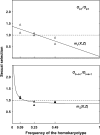Models of general frequency-dependent selection and mating-interaction effects and the analysis of selection patterns in Drosophila inversion polymorphisms
- PMID: 15911585
- PMCID: PMC1451186
- DOI: 10.1534/genetics.104.037754
Models of general frequency-dependent selection and mating-interaction effects and the analysis of selection patterns in Drosophila inversion polymorphisms
Abstract
We investigate mechanisms of balancing selection by extending two deterministic models of selection in a one-locus two-allele genetic system to allow for frequency-dependent fitnesses. Specifically we extend models of constant selection to allow for general frequency-dependent fitness functions for sex-dependent viabilities and multiplicative fertilities, while non-multiplicative mating-dependent components remain constant. We compute protected polymorphism conditions that take the form of harmonic means involving both the frequency- and the mating-dependent parameters. This allows for a direct comparison of the equilibrium properties of the frequency-dependent models with those of the constant models and for an analysis of equilibrium of the general model of constant fertility. We then apply the theory to analyze the maintenance of inversion polymorphisms in Drosophila subobscura and D. pseudoobscura, for which data on empirical fitness component estimates are available in the literature. Regression on fitness estimates obtained at different starting frequencies enables us to implement explicit fitness functions in the models and therefore to perform complete studies of equilibrium and stability for particular sets of data. The results point to frequency dependence of fitness components as the main mechanism responsible for the maintenance of the inversion polymorphisms considered, particularly in relation to heterosis, although we also discuss the contribution of other selection mechanisms.
Figures




References
Publication types
MeSH terms
LinkOut - more resources
Full Text Sources
Molecular Biology Databases

